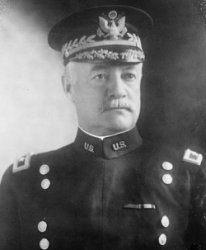
 |
|
|
||
|
Hunter Liggett |
||||
|
Graduate, U.S. Military Academy, Class of 1879 Engagements: • Spanish-American War (1898)• Philippine-American War (1899 - 1902)• World War I (1914 - 1918) |
||||
| Biography: | ||||
|
Hunter Liggett Hunter Liggett was born on 21 March 1857 in Reading, PA. After his graduation from the U.S. Military Academy and commissioning as a Second Lieutenant in 1879, he was assigned to the Fifth Infantry. He served in the Montana and Dakota Territories, as well as in Texas and Florida, during which time he reached the rank of First Lieutenant in June 1884. His field service in the American West, the Spanish-American War, and the Philippine-American War, honed his skills as a troop leader. In 1907, he assumed command of a battalion of the 13th Infantry Regiment at Fort Leavenworth, KS. From 1909-14, he served as student, faculty member, and President at the Army War College. The next year he took command of the 4th Brigade, 2nd Division at Texas City, TX. Liggett commanded Fort McKinley in the Philippines and his service there included setting up a Staff Ride to study possible invasion sites on Luzon. He was assisted in this by his Aide-de-Camp, Captain George C. Marshall. The Staff Ride established that the most likely invasion route would be through the Lingayen Gulf and that this would be all but unstoppable unless the U.S. dramatically increased its Army and Navy forces in the Philippines. [In 1941, the Japanese invaded through the Lingayen Gulf, as the U.S. did in turn in 1945.] Success in brigade commands in Texas and in the Philippines led to his selection as Commander of the 41st Infantry Division in France in 1917. When his Division was disestablished, he took command of I Corps as a temporary Lieutenant General. Under Liggett's leadership, I Corps participated in the Second Battle of the Marne and in the reduction of the Saint-Mihiel Salient. In January 1918, he served as General John J. Pershing's Chief of Staff. In October 1918, as Commander of the U.S. First Army, he directed the final phases of the Meuse-Argonne Offensive and the pursuit of German forces until the Armistice. After commanding the U.S. Third Army, also known as the Army of Occupation on the Rhein bridgeheads, Hunter Liggett retired in 1921. Congress promoted him to permanent Lieutenant General in 1930. Medals and Awards Distinguished Service Medal Legion of Honor (France) Order of Leopold (Belgium) Order of Saints Maurice and Lazarus (Italy) Honors In his honor the U.S. Army named a base on California's central coast, Fort Hunter Liggett as well as Hunter Liggett Army Airfield at Fort Stewart, GA. &Liggett Hall is a building on Governors Island in New York Harbor, which has the distinction of being the biggest building ever built by the Army until the construction of the Pentagon many years later. The USS Hunter Liggett was a passenger ship that was transferred to the Army and renamed Hunter Liggett in February 1939. The ship transported personnel and supplies until 27 May 1941, when she was turned over to the Navy. Converted to Navy use at Brooklyn Navy Yard, she re-commissioned as AP-27 on 9 June 1941, and then again reclassified APA-14 on 1 February 1943 for the U.S. Coast Guard. Death and Burial Lieutenant General Hunter Liggett died on 30 December 1935 in San Francisco, CA. He is buried at the San Francisco National Cemetery in San Francisco. |
||||
| Honoree ID: 2763 | Created by: MHOH | |||
Ribbons
Medals
Badges
Honoree Photos
 |  |  |
 |  |
 |


